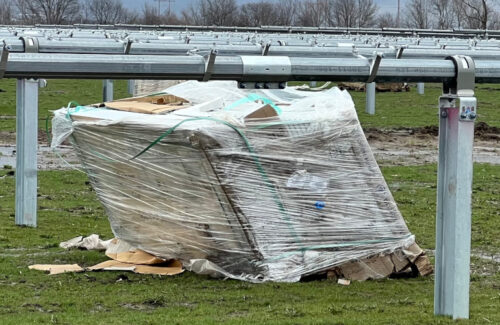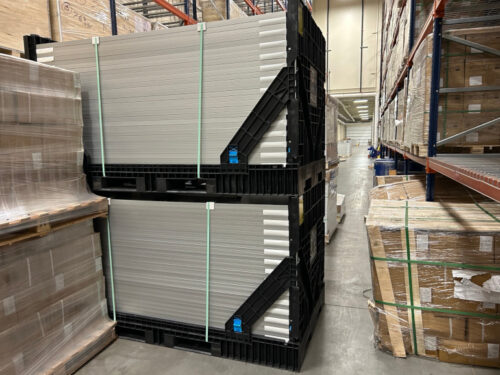For a product made primarily of fragile glass, solar panels can absorb many stressors and still successfully function well beyond their 30-year warrantied lifespans. After passing a barrage of tests — including mechanical stress, hail stress and thermal cycling — solar panels are given their stamp of approval and can be installed with few concerns about performance in the field.
The real risk for panel damage lies somewhere between leaving the module factory and finally being installed on roofs or in fields. Accidental breakage and component damage are most common in the shipping and handling stage, and although still only a small chance, the potential for even 1% of product loss due to damage can really add up.
“We tend to find at every touchpoint in the supply chain 1 to 2% breakage,” said Philip Schwarz, CEO and co-founder of PVpallet, a supplier of sustainable solar panel pallets made of recycled plastic. “You’re talking a small percentage, but it adds up to several million dollars of broken panels every year that could be avoided.”
The risk for damage is seen where solar panels are palleted and how hands or equipment get those modules to the next point in the chain. Panels are usually flat-stacked or stacked vertically in landscape-positioning on wooden pallets, wrapped in plastic or cardboard and secured with strapping bands. In a typical warehousing situation, that storage arrangement is fine for panel protection, said Tristan Erion-Lorico, VP of sales and marketing at Kiwa PVEL, an independent testing lab.
“Considering how many modules are stored in warehouses through the United States, we’re not getting calls for help with warranty claims because safe-harbored modules have self-destructed,” he said. “Module breakage in the field is a much bigger issue than breakage in storage.”
This may be due to the disposable packaging that solar panels are stored and shipped in. Wooden pallets don’t have the most stable bases, and wrapping modules in plastic film does little for 360° of protection. As soon as wrapping is cut on vertically stacked panels, those 50-lb panels are at risk of toppling over. And with solar panels getting larger, heavier and more awkward in size, the chance for damage just by unloading the product becomes larger.
“I’m a tall guy and I wouldn’t want to be standing next to one of those pallets as you open it up and try to unload it,” Erion-Lorico said. “I don’t know how they hold the modules securely as you’re going through the pallet. Even on their side, that’s still a lot of weight.”
In addition to being a more sustainable choice, the recyclable PVpallet is a safer packaging option for both the panels and the humans moving them. The company’s flagship Series X product is an industrial HDPE pallet with a steel-reinforced base and removable sidewalls. It can be adjusted to fit various module sizes and prevents the domino-effect of unwrapped pallets.
“That’s a big breakage point: when people unband or are trying to unload and load pallets, and the stack falls over and breaks,” Schwarz said. “We have load management handles in our walls that slide along a rail, so if they want to ship partial loads, those handles can sandwich [the panels] very tightly together. That keeps them upright and keeps them from falling over and contributing to additional breakage.”
The PVpallet’s adjustability is ideal for warehouses, especially when loose panels from multiple pallets must be re-grouped. The plastic pallet is also beneficial to large-scale installers working down long panel rows over many weeks or months in varying weather conditions. Solar panels situated on wooden pallets and wrapped in cardboard aren’t very well protected from the elements.
“Months of sitting out in the elements, the issue is the pallet falling over and there may be some glass breakage. But it’s also contaminants getting into connectors, and connectors not being shipped with caps,” Erion-Lorico said. “Pallets aren’t weather-tight. Sure, vertically stacking traditionally is safer from a microcracking perspective, but now you’ve got every cable at the bottom, sitting in a pallet that could be collecting water. The cardboard is decomposing, creating fibers that go into the water and into the connectors. That would be my biggest concern.”
Right now, there aren’t too many solutions for preventing shipping-and-handling damage to solar panels besides using common sense and the utmost care. There is a an International Electrotechnical Commission (IEC) code for testing the security of panels during the transportation of pallets. Although IEC 62759-1 largely tests how modules react to long-term truck transportation vibrations, increased industry scrutiny on this testing method could establish better practices for unloading panels using various packaging materials.
PVpallet would like its pallets in more warehouses and at the end of manufacturers’ lines. The company has an agreement with Minnesota panel manufacturer Heliene to load panels onto PVpallets for Heliene’s built-to-order panel supply agreements. Schwarz said PVpallet is focusing on more domestic panel manufacturing relationships, especially as the market grows. The company hopes to create a circular economy to cut down on a lot of waste and save a lot of broken panels in the process.
With so many imported panels now sitting in warehouses across the United States, more touchpoints will be happening as panels exchange hands more frequently before finding their end-customer. PVEL suggests testing modules at their first warehouse point to have the data that they’re working and being protected.
“Even in a non-temperature-controlled warehouse, [panels are] probably fine for an extended period,” Erion-Lorico said. “But even if you’re going to warehouse modules, doing procurement due diligence and testing the factory audits, having that data will make them a more fungible commodity.”









Thanks for the great article Kelly! Definitely an overlooked and major issue, especially as new larger module sizes and high transportation costs drive manufacturers to adopt vertical packaging. I wish I’d known you were working on this, I think we could have contributed and provided an example for a solution currently in use at a major US manufacturer. I work with Eckpack, who make a fitted, re-usable module shipping corner out of re-cycled plastic. Its passed IEC tests and was used extensively in Germany before being used in the US.
Really appreciate this perspective Kelly. In a thin margin business, every 1-2% of savings matters. Bigger frames + thinner glass and lower profile aluminum frames all spell trouble in terms of module damage …..if not during logistics, then during install, or when a big storm hits. We are working in the related space of delivering stronger, domestic steel frames that have a 90% lower carbon footprint vs. foreign aluminum.